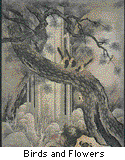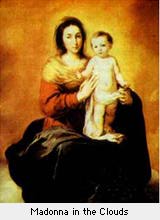|
Moore, Henry 1898-1986 British sculptor creating abstract conceptions of human figures in stone, bronze, and terra cotta.
While Michelangelo sought to free human forms from stone, Henry Moore left his abstract figures an integral part of the materials from which he carved them. His sculptures seem to be the product of natural forces, as if water and wind erosion created the negative spaces and hollows. In later years Moore exploited the fluid possibilities of bronze to further refine his forms, exploring the sculptural tension between voids and solids with such pieces as his 'Interior-Exterior Reclining Figure'
www link :
Kano Motonobu was one of the foremost artists of Japan. Into Chinese-style ink painting he introduced heavily stressed outlines and bold decorative patterns. His screen paintings served well as architectural decorations and appealed to the tastes of the warrior class. Many of his screen paintings are still preserved in temples of Kyoto.
www link :
Munch was often ill when he was a child, and in his art he turned again and again to the memory of illness, death and grief that he felt for losing his mother when he was only five. His work often included the symbolic portrayal of those themes. The Scream, probably his most familiar painting, is typical in its anguished expression of isolation and fear. While his early works were influenced by French-inspired Realism, in later years he became regarded as a pioneer in the Expressionist movement in modern painting.
www link :
Murillo was born in Seville and though he hardly ever left Seville Murillo's work reflects an admiration for 16th century Venetian painting, and for the great 17th century masters, particularly the Flemish and Genoese. His greatest activity occurred in the 1660's when he completed commissions for the Church of S.Maria la Blanca, the Capuchin Church (The Virgin and Child with Saints), the Hospital de la Caridad and the Cathedral, all in Seville. Murillo died in Seville after a fall while painting the large Marriage of S. Catherine for the high altar of the Capuchin Church in Cadiz.
www link :
|



